1973 DATSUN B110 brake
[x] Cancel search: brakePage 132 of 513
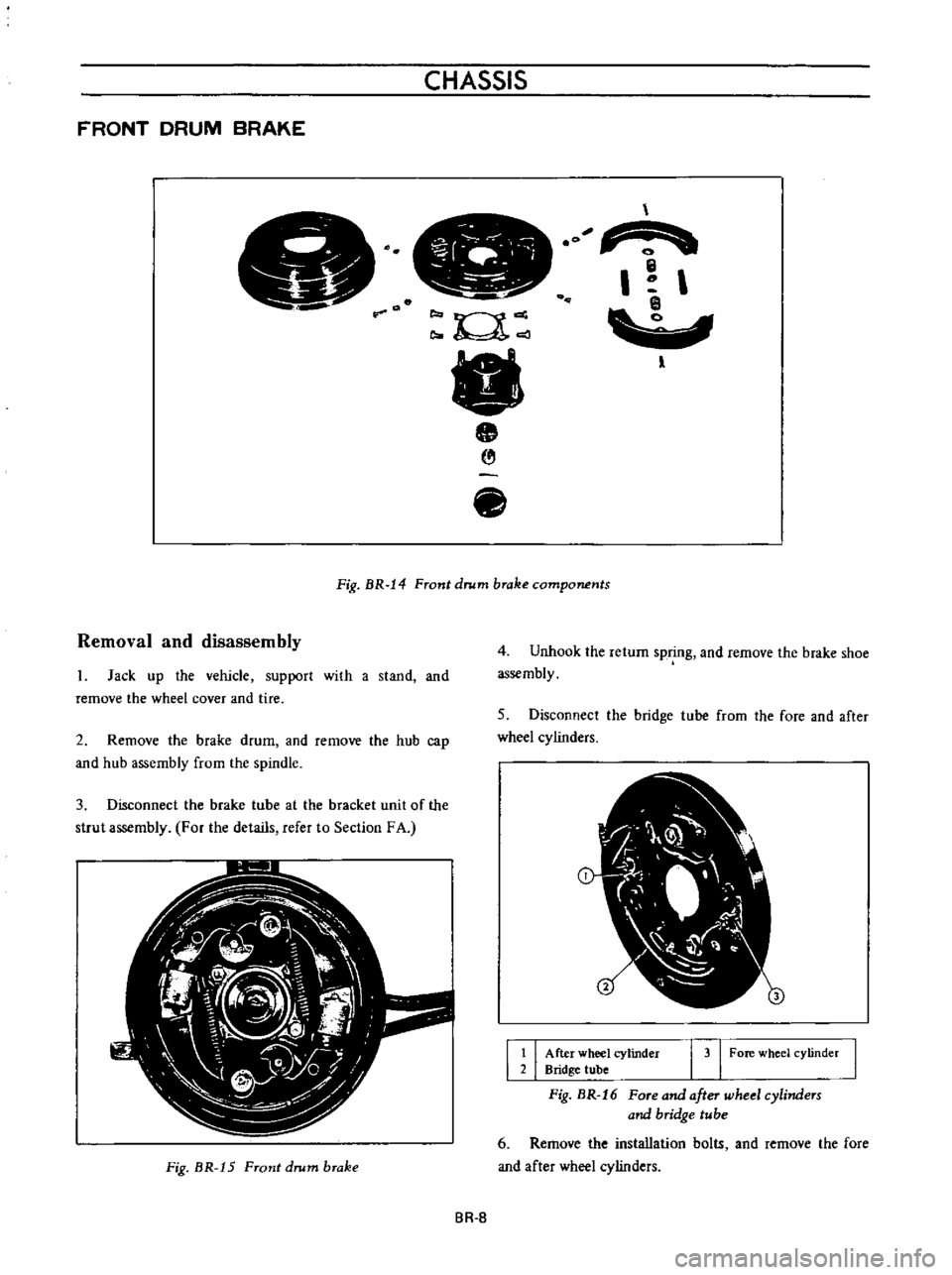
CHASSIS
FRONT
DRUM
BRAKE
14
I
l
Fig
BR
14
Front
drum
brake
components
Removal
and
disassembly
Jack
up
the
vehicle
support
with
a
stand
and
remove
the
wheel
cover
and
tire
2
Remove
the
brake
drum
and
remove
the
hub
cap
and
hub
assembly
from
the
spindle
3
Disconnect
the
brake
tube
at
the
bracket
unit
of
the
strut
assembly
For
the
details
refer
to
Section
FA
R
W
i
1
t
V
t
1
1
d
j
2
rl
s
J
J
i
Z
j
Fig
BR
15
Front
drum
brake
4
Unhook
the
return
spring
and
remove
the
brake
shoe
assembly
5
Disconnect
the
bridge
tube
from
lhe
fore
and
after
wheel
cylinders
I
I
After
wheel
cylinder
Bridge
tube
I
3
I
Fore
wheel
cylinder
Fig
BR
16
Fore
and
after
wheel
cylinders
and
bridge
tube
6
Remove
the
installation
bolts
and
remove
the
fore
and
after
wheel
cylinders
BR
B
Page 133 of 513
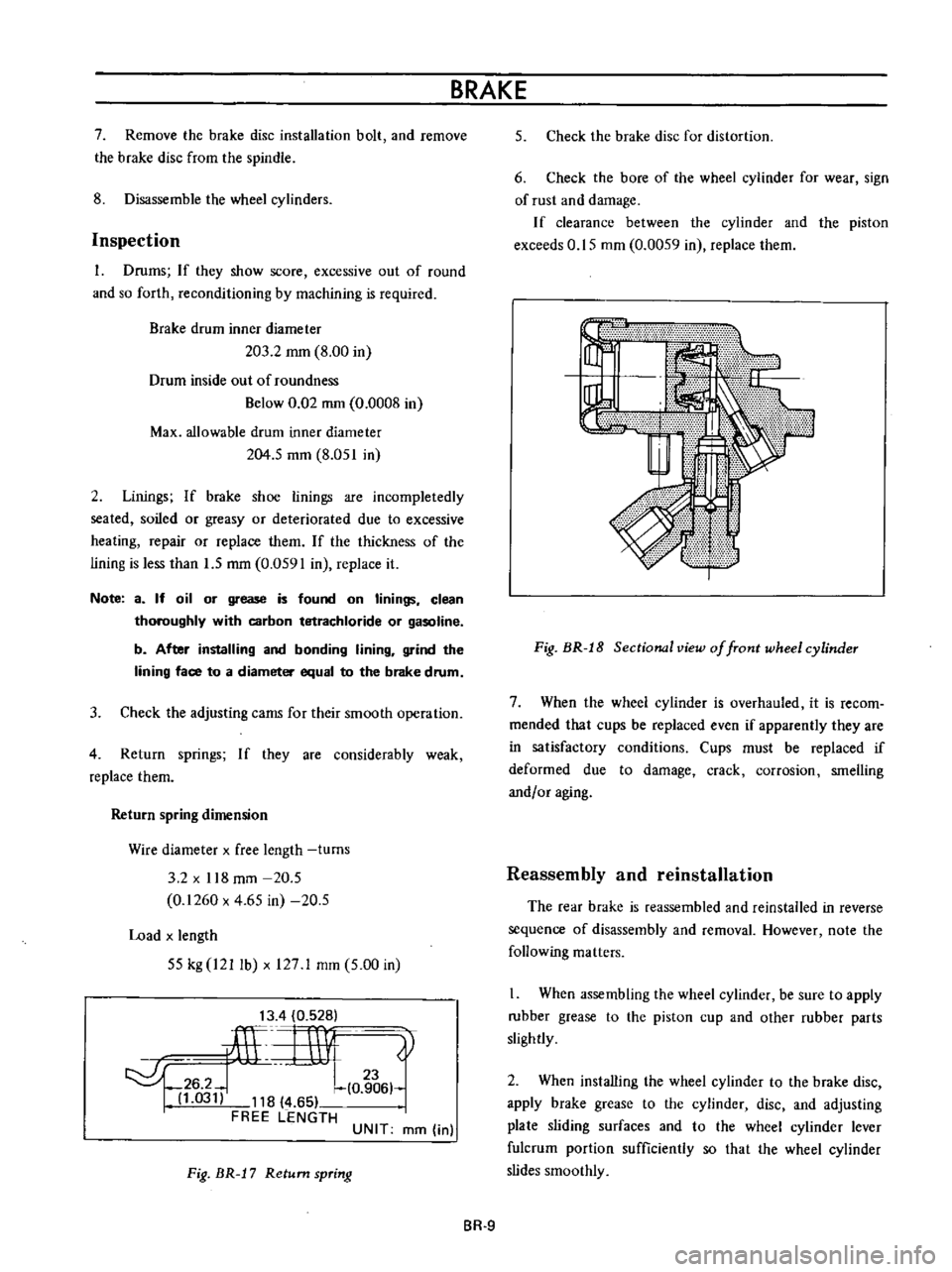
7
Remove
the
brake
disc
installation
bolt
and
remove
the
brake
disc
from
the
spindle
8
Disassemble
the
wheel
cylinders
Inspection
l
Drums
If
they
show
score
excessive
out
of
round
and
so
forth
reconditioning
by
machining
is
required
Brake
drum
inner
diameter
203
2
mm
8
00
in
Drum
inside
out
of
roundness
Below
0
02
mm
0
0008
in
Max
allowable
drum
inner
diameter
204
5
mm
8
051
in
2
Linings
If
brake
shoe
linings
are
incomp1etedly
seated
soiled
or
greasy
or
deteriorated
due
to
excessive
heating
repair
or
replace
them
If
the
thickness
of
the
lining
is
less
than
1
5
mm
0
0591
in
replace
it
Note
a
If
oil
or
grease
is
found
on
linings
clean
thoroughly
with
carbon
tetrachloride
or
gasoline
b
After
installing
and
bonding
lining
grind
the
lining
face
to
a
diameter
equal
to
the
brake
drum
3
Check
the
adjusting
cams
for
their
smooth
operation
4
Return
springs
If
they
are
considerably
weak
replace
them
Return
spring
dimension
Wire
diameter
x
free
length
turns
3
2
x
118
mm
20
5
0
1260
x
4
65
in
20
5
Load
x
length
55
kg
I21
lb
x
127
1
mm
5
00
in
13
4
0
528
ilL
rnv
0
t
6
hl
03
118
4
65
FREE
LENGTH
UNIT
mm
in
Fig
BR
J
7
Return
spring
BRAKE
5
Check
the
brake
disc
for
distortion
6
Check
the
bore
of
the
wheel
cylinder
for
wear
sign
of
rust
and
damage
If
clearance
between
the
cylinder
and
the
piston
exceeds
0
15
mm
0
0059
in
replace
them
Fig
BR
J
8
Sectional
view
of
front
wheel
cylinder
7
When
the
wheel
cylinder
is
overhauled
it
is
recom
mended
that
cups
be
replaced
even
if
apparently
they
are
in
satisfactory
conditions
Cups
must
be
replaced
if
deformed
due
to
damage
crack
corrosion
smelling
andf
or
aging
Reassembly
and
reinstallation
The
rear
brake
is
reassembled
and
reinstalled
in
reverse
sequence
of
disassembly
and
removal
However
note
the
following
matters
When
assembling
the
wheel
cylinder
be
sure
to
apply
rubber
grease
to
the
piston
cup
and
other
rubber
parts
slightly
2
When
installing
the
wheel
cylinder
to
the
brake
disc
apply
brake
grease
to
the
cylinder
disc
and
adjusting
plate
sliding
surfaces
and
to
the
wheel
cylinder
lever
fulcrum
portion
sufficiently
so
that
the
wheel
cylinder
slides
smoothly
BR
9
Page 134 of 513
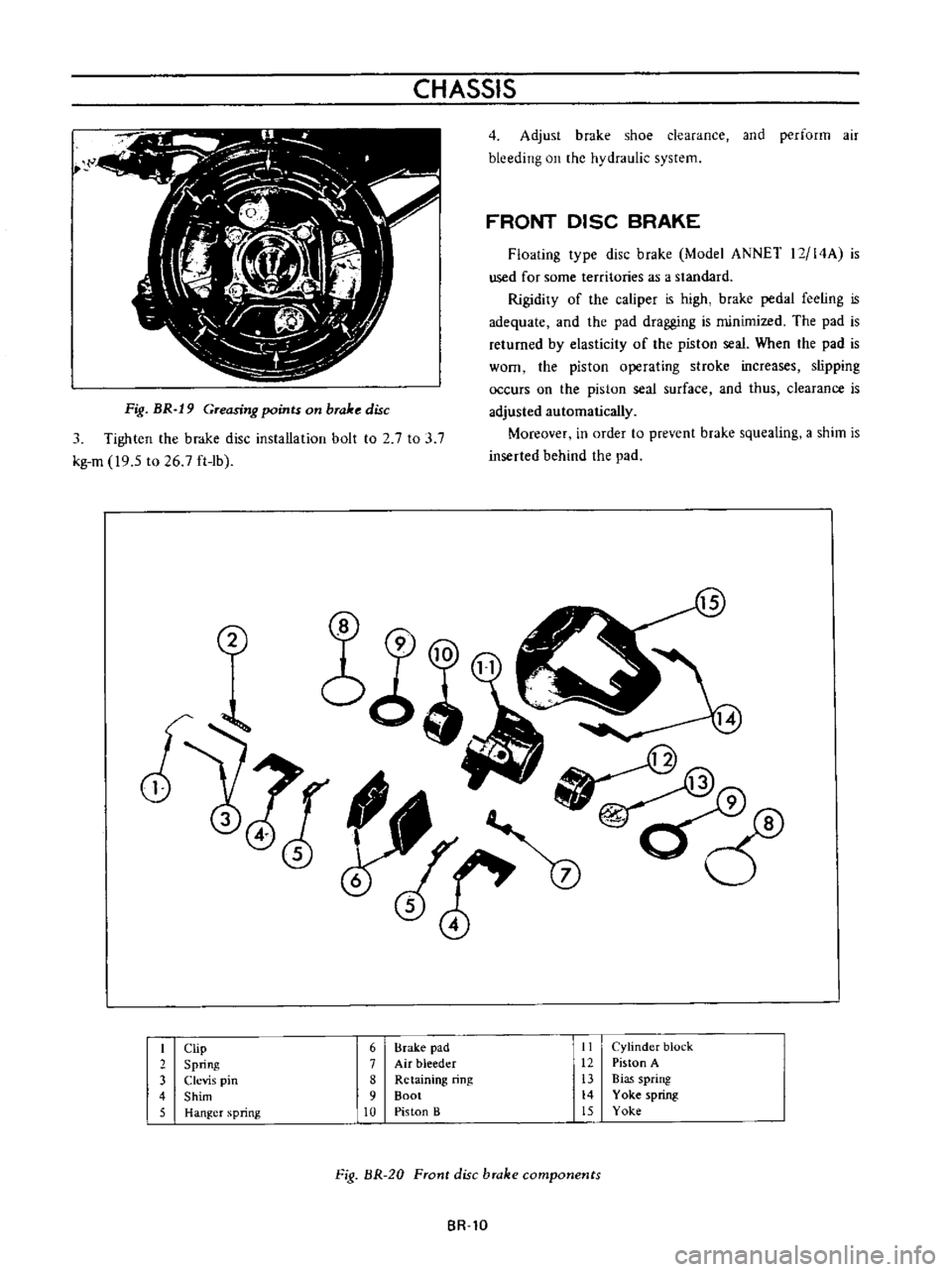
CHASSIS
Fig
BR
19
Greasing
points
on
brake
disc
3
Tighten
the
brake
disc
installation
bolt
to
2
7
to
3
7
kg
m
19
5
to
26
7
ft
lb
4
Adjust
brake
shoe
clearance
and
perform
air
bleeding
on
the
hydraulic
system
FRONT
DISC
BRAKE
Floating
type
disc
brake
Model
ANNET
12
14A
is
used
for
some
territories
as
a
standard
Rigidity
of
the
caliper
is
high
brake
pedal
feeling
is
adequate
and
the
pad
dragging
is
minimized
The
pad
is
returned
by
elasticity
of
the
piston
seal
When
the
pad
is
worn
the
piston
operating
stroke
increases
slipping
occurs
on
the
piston
seal
surface
and
thus
clearance
is
adjusted
automatically
Moreover
in
order
to
prevent
brake
squealing
a
shim
is
inserted
behind
the
pad
2
I
Clip
6
Brake
pad
II
Cylinder
block
2
Spring
7
Air
bleeder
12
Piston
A
3
Clevis
pin
8
Retaining
ring
13
Bias
spring
4
Shim
9
Boot
14
Yoke
spring
5
Hanger
spring
10
Piston
B
15
Yoke
Fig
BR
20
Front
disc
brake
components
BR
lO
Page 135 of 513

BRAKE
CYLINDER
SIDE
PISTON
SIDE
COMPR
ESSION
DECOMPRESSION
Movement
exceeding
the
elastic
displacement
is
released
with
slipping
on
the
seal
surface
Returns
in
elastic
displacement
of
the
seal
Fig
BR
21
Piston
seal
automatic
adjusting
operation
Brake
pad
Replacement
1
Jack
up
front
unit
of
the
vehicle
and
remove
lhe
front
wheeL
2
Remove
clip
from
the
retaining
pin
and
supporting
the
brake
pad
remove
the
retaining
pin
and
coil
spring
I
I
Brake
pad
2
Retaining
pin
I
31
Clip
Fig
BR
22
Removing
retaining
pin
3
Unhook
the
hanger
spring
and
withdraw
the
brake
pad
and
shim
with
a
pair
of
pliers
BR
ll
Fig
HR
2
Withdrawing
brake
pad
and
shim
Note
When
the
brake
pad
is
removed
do
not
depress
the
brake
pedal
or
otherwise
the
piston
will
come
out
Inspection
Clearance
between
the
brake
pad
and
rotor
is
adjusted
automatically
Check
the
brake
pad
for
wear
after
the
first
10
000
km
6
000
miles
driving
and
every
5
000
km
3
000
miles
thereafter
1
Clean
the
brake
pad
with
carbon
tetrachloride
or
gasoline
2
When
oil
and
or
grease
is
heavily
sticked
on
the
pad
or
when
deteriorated
or
deformed
due
to
overheating
replace
the
pad
with
a
new
one
3
When
thickness
of
the
friction
material
pad
is
less
than
1
6
mm
0
0630
in
replace
Replace
when
total
pad
thickness
is
less
than
6
1
mm
0
2402
in
Note
Replace
pads
as
a
set
Replacement
at
only
one
position
may
cause
uneven
brake
effect
It
is
recommended
that
rotation
of
pads
be
made
periodically
4
Check
the
rotor
Refer
to
Rotor
inspection
Reinstallation
1
Clean
the
calipers
and
piston
pad
installing
parts
Note
Do
not
use
mineral
oil
Be
careful
not
to
apply
oil
on
the
rotor
2
Depress
the
piston
into
the
cylinder
so
that
new
pad
can
be
installed
Page 136 of 513

CHASSIS
Fig
BR
24
Depression
piston
A
and
B
into
cylinder
Nota
a
Nota
that
brake
fluid
may
overflow
from
the
reservoir
It
is
recommeooed
that
operation
be
carried
out
by
loosening
the
breather
to
release
brake
fluid
b
The
piston
can
be
easily
pushed
in
by
hand
But
if
pushed
excessively
the
groove
of
piston
goes
inside
of
seal
as
shown
in
Figure
BR
25
and
the
seal
will
be
damaged
When
the
piston
is
pushed
excessively
into
the
cylinder
remove
the
brake
assembly
disassemble
it
push
out
the
piston
to
the
arrow
direction
as
shown
in
Figure
BR
25
and
reassemble
r
w
i
@
I
I
I
I
i
I
I
I
1
I
1
1
Piston
ieat
1
2
I
Normal
position
I
Fig
BR
25
Piston
pushing
in
position
3
Install
pad
and
anti
squeal
shim
assemble
the
anti
squeal
spring
and
retaining
pin
and
secure
them
with
clip
ARROW
MARK
Fig
BR
26
Arrow
mark
on
shim
I
Install
the
shim
so
that
the
arrow
mark
points
the
rotor
forward
rotating
direction
2
Apply
the
coil
spring
to
the
retaining
pin
which
is
distanced
from
the
air
bleeder
4
When
the
pad
is
installed
depress
the
brake
pedal
several
times
so
as
to
settle
down
the
pad
in
the
position
Caliper
assembly
Removal
L
Remove
the
brake
pad
Refer
to
Pad
re
placement
2
Disconnect
the
brake
tube
from
the
wheel
cylinder
3
Remove
the
strut
assembly
and
knuckie
arm
instal
lation
bolt
so
as
to
ease
removal
of
the
caliper
assembly
installation
bolt
BR
12
Page 137 of 513
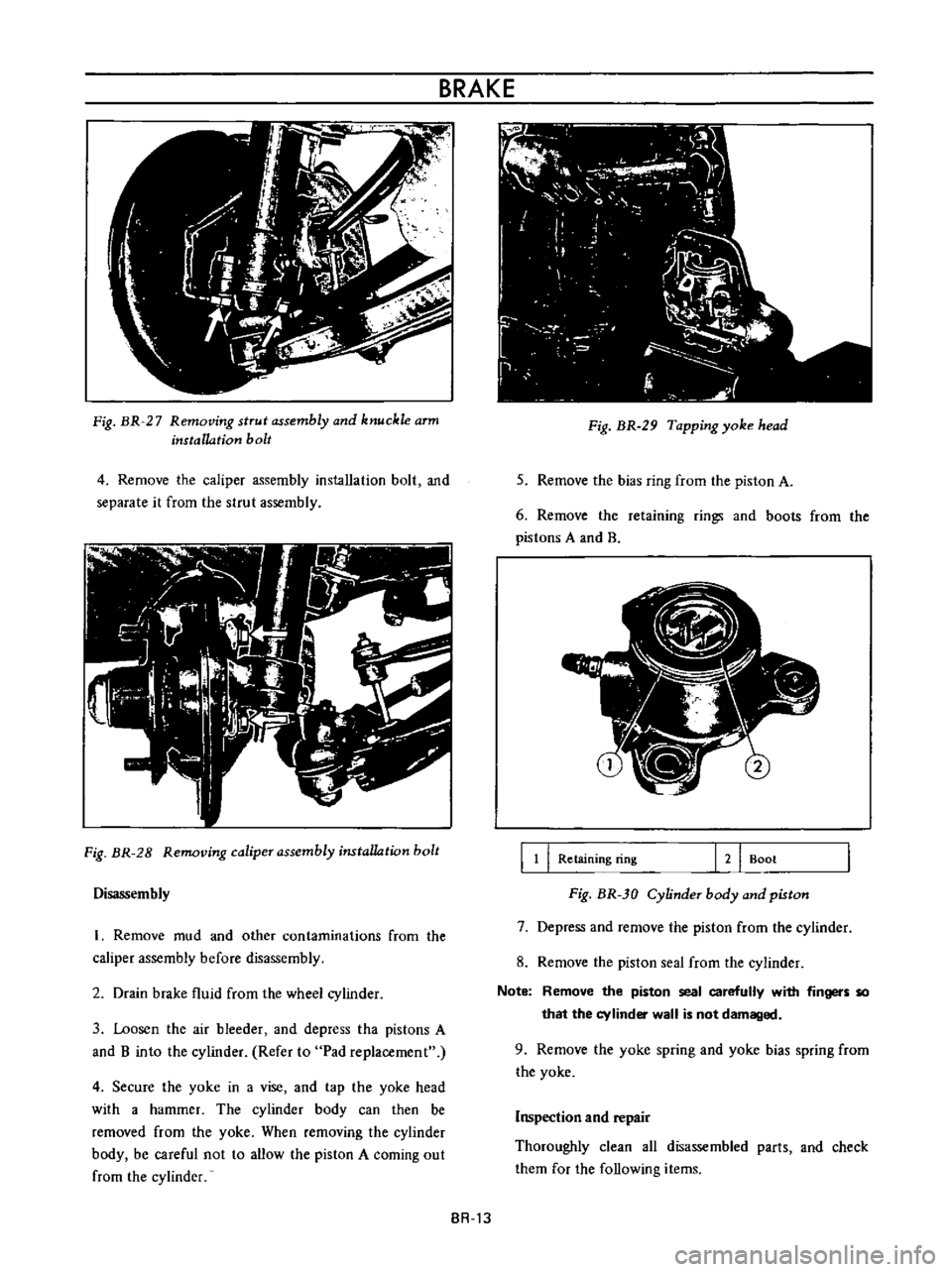
BRAKE
Fig
BR
27
Removing
strut
assembly
and
knuckle
arm
installation
bolt
4
Remove
the
caliper
assembly
installation
bolt
and
separate
it
from
the
strut
assembly
Fig
BR
28
Removing
caliper
assembly
instaUation
bolt
Disassembly
I
Remove
mud
and
other
contaminations
from
the
caliper
assembly
before
disassembly
2
Drain
brake
fluid
from
the
wheel
cylinder
3
Loosen
the
air
bleeder
and
depress
tha
pistons
A
and
B
into
the
cylinder
Refer
to
Pad
replacement
4
Secure
the
yoke
in
a
vise
and
tap
the
yoke
head
with
a
hammer
The
cylinder
body
can
then
be
removed
from
the
yoke
When
removing
the
cylinder
body
be
careful
not
to
allow
the
piston
A
coming
out
from
the
cylinder
BR
13
i
c
J
l
l
7
I
0
I
I
i
I
f
1
1
J
t
1
Fig
BR
29
Tapping
yoke
head
5
Remove
the
bias
ring
from
the
piston
A
6
Remove
the
retaining
rings
and
boots
from
the
pistons
A
and
B
J
l
lj
7
fI
II
l
j
B
11
I
Retaining
ring
121
Boot
Fig
BR
30
Cylinder
body
and
piston
7
Depress
and
remove
the
piston
from
the
cylinder
8
Remove
the
pislon
seal
from
the
cylinder
Note
Remove
the
piston
seal
carefully
with
fingers
so
that
the
cylinder
wall
is
not
damaged
9
Remove
the
yoke
spring
and
yoke
bias
spring
from
the
yoke
Inspection
and
repair
Thoroughly
clean
all
disassembled
parIs
and
check
them
for
the
following
items
Page 138 of 513

CHASSIS
Note
When
cleaning
rubber
parts
use
alcohol
or
brake
fluid
If
rubber
parts
are
cleaned
with
mineral
oil
they
will
be
deteriorated
1
Calipers
If
the
cylinder
wall
is
damaged
or
worn
replace
If
the
cylinder
wall
is
rusted
or
foreign
matters
are
accumu
lated
on
the
cylinder
wall
carefully
polish
with
fine
emery
paper
so
that
the
cylinder
wall
is
not
damaged
If
rusted
or
roughened
excessively
replace
2
Pad
See
paragraph
covering
replacement
of
pad
3
Piston
Replace
if
unevenly
worn
damaged
and
or
rusted
Note
The
piston
sliding
surface
is
plated
Thus
do
not
use
emery
paper
although
rusted
or
foreign
matters
are
Slicked
on
the
sliding
surface
4
Seals
Primarily
replace
both
piston
and
dust
seals
whenever
overhauling
Note
The
piston
seal
affects
not
only
leaking
but
also
piston
return
For
this
reason
replace
the
piston
seal
even
if
the
damage
is
minor
S
Rotor
Check
the
rotor
and
if
it
shows
score
excessively
out
of
round
and
so
forth
reconditioning
by
machining
is
required
If
any
abnormal
conditions
such
as
crack
distortion
and
excessive
deflection
replace
the
rotor
Standard
rotor
thickness
9
5
mm
0
3740
in
Limit
of
reconditionillg
rotor
in
thkkn
8
4
mm
0
3307
in
Deflection
of
the
rotor
Below
0
03
mm
0
0012
in
I
I
I
I
ri
U
h
J
r
Fig
BR
1
Measuring
deflection
of
disc
Reassembly
Apply
the
rubber
grease
to
cylinder
bore
and
install
the
piston
seal
2
Insert
the
bias
ring
to
piston
A
so
that
the
roundish
portion
of
bias
ring
comes
to
the
bottom
of
piston
1
ilY
f@
I
I
C
I
1
n
tL
c
ffi
1
1
fJ
u
IZ
@
I
I
Yoke
Chamfer
13
PistonA
I
4
Roundish
portion
Fig
BR
32
Installing
bias
ring
into
piston
A
Note
Be
careful
not
to
confuse
the
piston
A
with
B
BR
14
Page 139 of 513
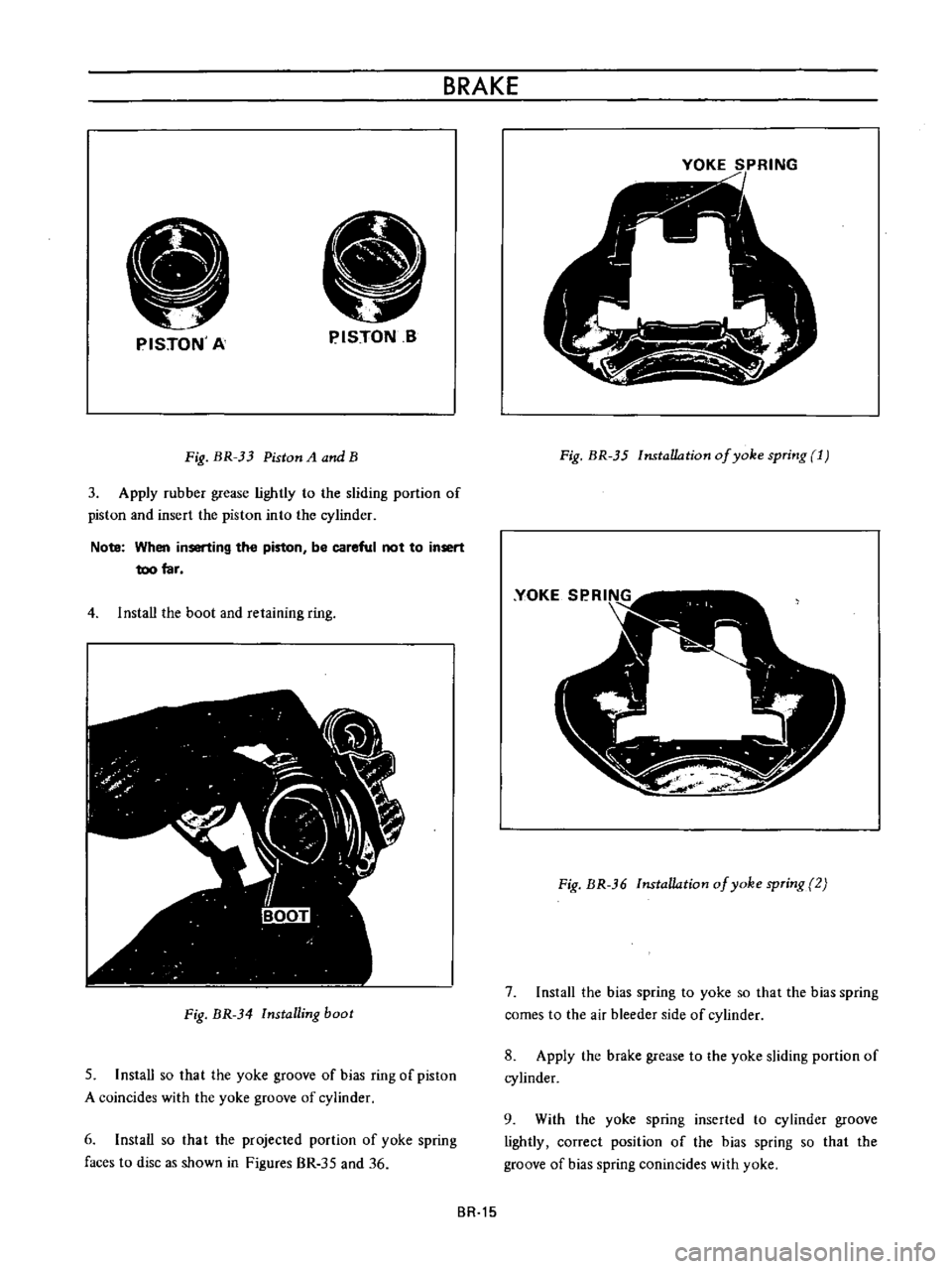
BRAKE
i
f
F
PISTON
A
PISTON
S
Fig
BR
33
Piston
A
and
B
3
Apply
rubber
grease
lightly
to
the
sliding
portion
of
piston
and
insert
the
piston
into
the
cylinder
Note
When
inserting
the
piston
be
careful
not
to
insert
too
far
4
1
nstaU
the
boot
and
retaining
ring
Fig
BR
34
Installing
boot
5
Install
so
that
the
yoke
groove
of
bias
ring
of
piston
A
coincides
with
the
yoke
groove
of
cylinder
6
Install
so
that
the
projected
portion
of
yoke
spring
faces
to
disc
as
shown
in
Figures
BR
35
and
36
BR
15
YOKE
SPRING
Fig
BR
35
Installation
of
yoke
spring
1
Fig
BR
36
Installation
of
yoke
spring
2
7
Install
the
bias
spring
to
yoke
so
that
the
bias
spring
comes
to
the
air
bleeder
side
of
cylinder
8
Apply
the
brake
grease
to
the
yoke
sliding
portion
of
cylinder
9
With
the
yoke
spring
inserted
to
cylinder
groove
lightly
correct
position
of
the
bias
spring
so
that
the
groove
of
bias
spring
conincides
with
yoke